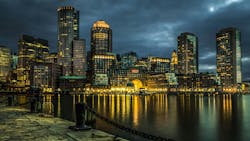Boost Energy Savings, Protect Wildlife, and Promote Wellbeing by Reducing Light Pollution
October evenings find birds across North America reading the night sky as they migrate to their wintering grounds, making the hazards of outdoor illumination a timely topic. Fittingly, the DesignLights Consortium (DLC) is putting finishing touches on a presentation focused on ways to mitigate light pollution that hampers not only birds and other wildlife, but human wellbeing too.
As we prepare for our “Wasted Light at Night” panel at the sold-out DLC Controls Summit next week (10/16), an August 2024 study has estimated that collisions with building glass result in over one billion bird fatalities in the US per year.
Light at night attracts birds from their migratory paths into urban areas and disorients them once they are in cities and suburbs. Birds do not seem to see transparent glass. Instead, they see images reflected off the glass or the interior space a building (the latter known as the "lantern effect”). Network lighting controls (NLCs) can help facility managers dim or switch off their interior lighting at night using occupancy sensors and programable schedules. This saves energy and reduces the "lantern effect” to lessen bird collisions. Some NLCs can also control window shades to darken windows if spaces must be occupied at night.
The DLC’s NLC Qualified Products List (QPL) provides information about system capabilities for more than 70 NLC systems that can control lighting in spaces ranging from single rooms or zones to whole buildings, campuses and portfolios. Readers can browse and compare products on the NLC QPL for free by creating a DLC user account.
Light pollution from poorly shielded, misdirected and/or excessive outdoor lighting, has accelerated by about 10 percent annually over the past decade – equivalent to doubling the brightness of the night sky every eight years. Unlike many other environmental challenges, however, reining in wasted light at night – and the higher electric bills it causes – has readily available solutions.
Choosing to install light mitigating outdoor fixtures, such as those on the DLC’s third-party vetted LUNA QPL, is a practical way for commercial lighting decision makers to reduce sky glow and light trespass from outside lighting. While there may be a perception that light pollution mitigating lights are less efficient and more costly than energy efficient LEDs, the reality is it’s possible to have the best of both worlds. Products on the LUNA QPL not only check several boxes for light pollution mitigation, but also meet all the DLC’s thresholds for efficacy, quality, controllability, and reliability – making them eligible for cost-saving rebates from most North American energy efficiency programs. And, with nearly 370 products listed on the LUNA QPL, there are many options.
A DLC study published over the summer illustrated just how effective LUNA-listed products are in meeting both efficiency and sustainability goals. Our study compared energy usage and cost impact of LED luminaires that meet LUNA requirements with products geared toward efficiency alone. Measured against outdoor LED installations focusing only on energy efficiency, LUNA-qualified products installed with proper design and controls implementation can significantly reduce light pollution and save more energy, the study showed.
Panelists at the DLC Summit panel will examine a broad set of issues regarding benefits of managing commercial building lighting at night with the goal of maximizing energy savings and reducing light emitted from buildings. You can watch the session preview here.
And, to learn more about how reducing light pollution aids the billions of birds migrating through the US this fall – mostly at night, check out the Cornell Lab’s BirdCast dashboards and its Lights Out campaigns that urge commercial buildings to turn off or dim nighttime illumination during migration season to avoid attracting and disorienting migrating birds and allow them to proceed safely with their seasonal journeys.
About the Author

Leora Radetsky
Leora Radetsky is the DesignLights Consortium’s Senior Lighting Scientist and LUNA Program Director.
